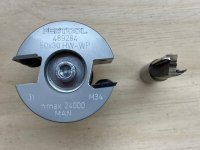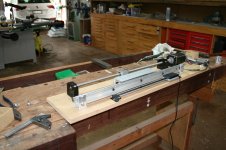Cheese, did u ever go with the Shaper Origin? Thoughts? I always appreciate your insightful contributions on this forum through the years. Thx for being such a great contributor. A few questions, u or anyone....
I have considered a Shaper too, but from my research it uses the small 1010 motor from Festool... why not use a much quieter and more powerful air cooled CNC motor which offers better collet sizes? It's a relatively higher end product and has great value, even offering an option for such would think would expand their user base. any thoughts?
I would think offering a CNC air cooled spindle would offer additional accuracy with the collets as well, which is significant if you use the Shaper for detailed joinery work such as dovetails. Shaper has never really expressed how accurate their system is..at least that I have seen. For most applications, extreme accuracy not that critical, but for very fine detailed joinery or inlays, accuracy matters.
I have the WP router lift with the Milwaukee 3.25hp... my only issue with the WP lift is the Lift mechanism to change bits, a bit cumbersome with the push rod and spring system as it gets very sticky through the years. Glad to see others have come up with a cleaner system for moving the spindle up n down. I would like to replace my Milw with a quiet air cooled or water cooled spindle, I have 240v avail. Does anyone have a recommendation that would fit in my WP lift?
BTW, does anyone make a router table system with the air / water cooled spindle w lift? This would surely elevate router tables for the lite commercial user.
For handheld routers, is there any CNC air cooled spindles that fit in existing bases, such as Milw, Bosch, DW, Festool, etc? This again is primarily for sound reduction and better collet size options. thx in advance.
I have considered a Shaper too, but from my research it uses the small 1010 motor from Festool... why not use a much quieter and more powerful air cooled CNC motor which offers better collet sizes? It's a relatively higher end product and has great value, even offering an option for such would think would expand their user base. any thoughts?
I would think offering a CNC air cooled spindle would offer additional accuracy with the collets as well, which is significant if you use the Shaper for detailed joinery work such as dovetails. Shaper has never really expressed how accurate their system is..at least that I have seen. For most applications, extreme accuracy not that critical, but for very fine detailed joinery or inlays, accuracy matters.
I have the WP router lift with the Milwaukee 3.25hp... my only issue with the WP lift is the Lift mechanism to change bits, a bit cumbersome with the push rod and spring system as it gets very sticky through the years. Glad to see others have come up with a cleaner system for moving the spindle up n down. I would like to replace my Milw with a quiet air cooled or water cooled spindle, I have 240v avail. Does anyone have a recommendation that would fit in my WP lift?
BTW, does anyone make a router table system with the air / water cooled spindle w lift? This would surely elevate router tables for the lite commercial user.
For handheld routers, is there any CNC air cooled spindles that fit in existing bases, such as Milw, Bosch, DW, Festool, etc? This again is primarily for sound reduction and better collet size options. thx in advance.



